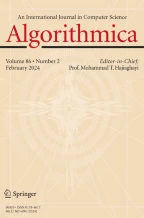Abstract
This paper introduces the largest connected subgraph game played on an undirected graph G. In each round, Alice first colours an uncoloured vertex of G red, and then, Bob colours an uncoloured vertex of G blue, with all vertices initially uncoloured. Once all the vertices are coloured, Alice (Bob, resp.) wins if there is a red (blue, resp.) connected subgraph whose order is greater than the order of any blue (red, resp.) connected subgraph. We first prove that, if Alice plays optimally, then Bob can never win, and define a large class of graphs (called reflection graphs) in which the game is a draw. We then show that determining the outcome of the game is PSPACE-complete, even in bipartite graphs of small diameter, and that recognising reflection graphs is GI-hard. We also prove that the game is a draw in paths if and only if the path is of even order or has at least 11 vertices, and that Alice wins in cycles if and only if the cycle is of odd length. Lastly, we give an algorithm to determine the outcome of the game in cographs in linear time.
Similar content being viewed by others
Notes
Generalised Hex is a generalisation of Hex played on graphs, where the two players alternate picking vertices, with the first player aiming to join two fixed vertices s and t by a path formed by their vertices, while the second player aims at preventing this from happening.
References
Andres, S.D., Huggan, M., Mc Inerney, F., Nowakowski, R.J.: The orthogonal colouring game. Theor. Comput. Sci. 795, 312–325 (2019)
Bensmail, J., Fioravantes, F., Mc Inerney, F., Nisse, N.: The largest connected subgraph game. In: Proceedings of the 47th International Workshop on Graph-Theoretic Concepts in Computer Science (WG 2021), Lecture Notes in Computer Science, vol. 12911, pp. 296–307. Springer (2021)
Bonnet, E., Jamain, F., Saffidine, A.: On the complexity of connection games. Theor. Comput. Sci. 644, 2–28 (2016)
Browne, C.: Connection Games: Variations on a Theme. AK Peters, Natick (2005)
Bruno, J., Weinberg, L.: A constructive graph-theoretic solution of the Shannon switching game. IEEE Trans. Circuit Theory 17(1), 74–81 (1970)
Changat, M., Lekha, D.S., Peterin, I., Subhamathi, A.R., Spacapan, S.: The median game. Discrete Optim. 17, 80–88 (2015)
Corneil, D.G., Perl, Y., Stewart, L.K.: A linear recognition algorithm for cographs. SIAM J. Comput. 14(4), 926–934 (1985)
Duchêne, E., Gonzalez, S., Parreau, A., Rémila, E., Solal, P.: INFLUENCE: a Partizan scoring game on graphs. Theor. Comput. Sci. 878–879, 26–46 (2021)
Even, S., Tarjan, R.E.: A combinatorial problem which is complete in polynomial space. J. ACM JACM 23(4), 710–719 (1976)
Gardner, M.: The Scientific American Book of Mathematical Puzzles & Diversions. Simon and Schuster, New York (1959)
Gardner, M.: The Second Scientific American Book of Mathematical Puzzles and Diversions. Simon and Schuster, New York (1961)
Larsson, U., Nowakowski, R.J., Neto, J.P., Santos, C.P.: Guaranteed scoring games. Electron. J. Combin. 23(3), P3.27 (2016)
Larsson, U., Nowakowski, R.J., Santos, C.P.: Game comparison through play. Theor. Comput. Sci. 725, 52–63 (2018)
Larsson, U., Nowakowski, R.J., Santos, C.P.: Games with guaranteed scores and waiting moves. Int. J. Game Theory 47(2), 653–671 (2018)
Micek, P., Walczak, B.: A graph-grabbing game. Combin. Probab. Comput. 20(4), 623–629 (2011)
Reisch, S.: Hex ist PSPACE-vollständig. Acta Inf. 15(2), 167–191 (1981)
Schaefer, T.J.: On the complexity of some two-person perfect-information games. J. Comput. Syst. Sci. 16(2), 185–225 (1978)
Shapovalov, A.: Occupation games on graphs in which the second player takes almost all vertices. Discrete Appl. Math. 159(15), 1526–1527 (2011)
Author information
Authors and Affiliations
Corresponding author
Additional information
Publisher's Note
Springer Nature remains neutral with regard to jurisdictional claims in published maps and institutional affiliations.
This work has been supported by the European Research Council (ERC) consolidator Grant No. 725978 SYSTEMATICGRAPH, the STIC-AmSud project GALOP, the PHC Xu Guangqi project DESPROGES, and the UCA\(^\textit{JEDI}\) Investments in the Future project managed by the National Research Agency (ANR-15-IDEX-01). An extended abstract of parts of this paper has been presented in [2]
Rights and permissions
About this article
Cite this article
Bensmail, J., Fioravantes, F., Mc Inerney, F. et al. The Largest Connected Subgraph Game. Algorithmica 84, 2533–2555 (2022). https://doi.org/10.1007/s00453-022-00973-5
Received:
Accepted:
Published:
Issue Date:
DOI: https://doi.org/10.1007/s00453-022-00973-5
